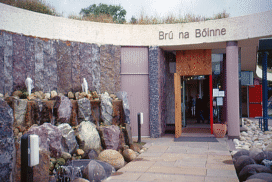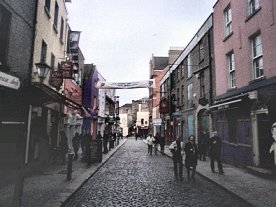 Bru
na Boinne - Layers of Irish history
Bru
na Boinne - Layers of Irish history
The river valley of the Boyne, or "Bru na Boinne" (The palace of the
Boyne) is famous for its large number of neolithic tombs and mythical
settings, among them the three large passage graves Newgrange, Howth and
Dowth. But in terms of Irish history, there is far more in store.
Taking a bus from Dublin on a bright sunny day, we arrive at the Newgrange site around noon time. Newgrange is the largest, and maybe most important site in what can be called Ireland's "Valley of the Kings". In the Boyne valley, there are more than 40 graves and ritual sites dating back to 3200 BC and therefore older than the Egyptian pyramids, but Newgrange is obviously the most impressive one. We are allowed to enter the actual through the entrance which is in the middle of a huge wall of white, reflecting stones. Nicola, our guide - the grave can only be visited on a tour - tells us that the whole front wall had broken down when the grave was discovered, due to about 200,000 tons of stone pressing outward. Archaeologists reconstructed the wall only to let it tumble down again, finding that the stones had fallen to exactly the same places they were originally found in. This was taken as proof that there originally was a front wall surrounding the tomb, which was then properly reconstructed and fixed and now looks more space age than stone age.
But more impressive than the wall itself is the actual material. Most of the stones are from the area, but tons of the white frontwall stones can only be found in the Wicklow mountains, roughly about 70 miles from the site, and decorative football size pebbles obviously come from the coast, 50 miles from here. This is even more impressive realizing that during the Neolithic age, the whole area was covered by wood, and the actual builders had neither horses nor the wheel. The whole construction seems to have taken about 80 years, an immensely long period of time, give that normal life expectancy was around 30 years.
 Before
we enter the tomb, Nicola explains that the people who constructed this
tomb obviously used the site as a kind of observatory. Like other passage
tombs, the 20 meter long passage is exactly in line with the sunbeams
on winter solstice, the shortest day in the year. In this particular grave,
there is even a little "extra" - The so called roof box above the entrance,
an extra window or entrance for the sunbeams. During dawn, the sun comes
up over the mountains on the opposite side of the valley and enters through
this window. As the passage slowly rises, the roof box above the door
is on the same level as the floor in the actual chamber, first only painting
a thin line on the floor and then slowly lighting the whole chamber.
Before
we enter the tomb, Nicola explains that the people who constructed this
tomb obviously used the site as a kind of observatory. Like other passage
tombs, the 20 meter long passage is exactly in line with the sunbeams
on winter solstice, the shortest day in the year. In this particular grave,
there is even a little "extra" - The so called roof box above the entrance,
an extra window or entrance for the sunbeams. During dawn, the sun comes
up over the mountains on the opposite side of the valley and enters through
this window. As the passage slowly rises, the roof box above the door
is on the same level as the floor in the actual chamber, first only painting
a thin line on the floor and then slowly lighting the whole chamber.
Squeezing through the narrow passage way - not for the faint hearted! - Nicola tells us that the sunbeams actually enter the tomb from 19 to 24 December. If there is any sun, that is. She has already been there on several occasions, but only seen it once. Inside the tomb, we are quite surprised that the stones are beautifully decorated, mainly with spiral symbols. There are three recesses with huge stone dishes for the ashed of the dead. But obviously, not the middle one, which is hit by the sunbeams directly, is the most important, but the one to the right, which has two decorated dishes and elaborate spiral symbols all around it. To us, this doesn't really seem to fit into the picture of a society building such a huge monument around the passage of the sun, but unfortunately, we cannot ask the builders what the reason is.
Finally - to make things even worse for claustrophobics - Nicola turns off the light and demonstrates the effect of the incoming sun with articifial light. After that, we feel we should really take a chance and put our names down for the annual lottery for the fifty tickets on 21 December!
Back on the bus, our bus driver, Sean, tells us that Newgrange is not only the cradle of Irish civilization, but also the site of the Battle of the Boyne, a more recent, but nevertheless quite important point in Irish history. Though the battle grounds of a completely un-Irish war - the battle between the Catholic James II and the Dutch William of Orange, it sealed the country's fate for the next 300 years. In 1690, Irish soldiers supported James II who lost the battle. James fled to France, leaving behind a country now completely under Protestant rule. Catholic land was confiscated and the penal laws are introduced.
Travelling along the Boyne valley, we go back to mystic times again, visiting the hills of Tara, the legendary site of the of the High Kings of Ireland until the 11th century. And again, we find a second layer of history here. The power of the site was not lost on Daniel O'Connell. Coming from a rich but Catholic family, he was forced to get his education in France, where he witnessed the French Revolution. Obviously, he was quite shocked by the sheer violence of the proceedings and became the organizer of the first peaceful civil rights movement ever. He managed to gather one million Catholics on sites like Tara - an even more impressive number given the fact that hardly any of the 8 million Irish Catholics of that time had horses or carriages to travel. Obviously, this even struck the English, who eventually passed the Emancipation Act and other slight improvements for the Catholics.
And there's a final bit of historical irony connected with O'Connell. Though people like Mahatma Ghandi and the American civil rights movement modelled their actions on O'Connell's ideas, he himself finally lost the support of his people when calling off his actions under English threat of violence.
Alexandra Haas
 Ulysses
- Visit to Irish Film Centre
Ulysses
- Visit to Irish Film CentreOne of the most important cultural institutions of Temple Bar in Dublin is the Irish Film Centre, which is supported by the Europa Cinemas, the Media Programme of the European Union. It shows among others especially independent and artistic film productions. We had the chance to watch the new "premiere" of Ulysses in Ireland. The film was banned by censorship in Ireland and many other countries shortly after the production in 1967. It is based on James Joyce novel with the same title and provided us with an audiovisual link to the work, which was presented to us at the James Joyce center. The experimental and poetic montage of scenes and visual elements are an interesting cinematic interpretation of the hypertext like structures in Joyce novel.
Visit to the Trinity College Library Dublin
Trinity College Library Library Dublin holds the largest collection
of manuscripts and printed books in Ireland. It has existed since the
foundation of the university in 1592. It contains a Treasury for the display
of Irish medievial gospel manuscripts, principally the Book
of Kells, produced in the 9th century by the monks of Iona, the Book
of Armagh and the Book of Durrow. The Book
of Kells, a product of Irish monasticism, contains a Latin version
of the Gospels in the New Testament. Scholars date the book to approximately
800 A.D. Although Iona and Northumbria are still discussed as possible
"birth" places for the manuscript, its final residence was Kells, located
thirty miles north west of Dublin. It is with this monastery that the
book is associated. The Book
of Kells is the most recognized and most remarkable artifact of medieval
Celtic art. It features page after page of lavish, colorful lettering,
illumination, decoration and illustration. To a large extent, the great
reputation which Celtic art and design have today is based on the exceptional
quality of the images found in the Book of Kells. Giraldus Cambrensis,
13th century scholar: "Look closely at it and you will penetrate the innermost
secrets of art; you will find embellishments of such intricacy, such a
wealth of knots and interlacing links that you might believe it was the
work of an angel rather than a human being." A treasure itself is also
the Long Room, the main chamber of the Old Library . It houses the oldest
books of the library and a famous harp the oldest to survive from Ireland
and probably dates from the 15th century.

